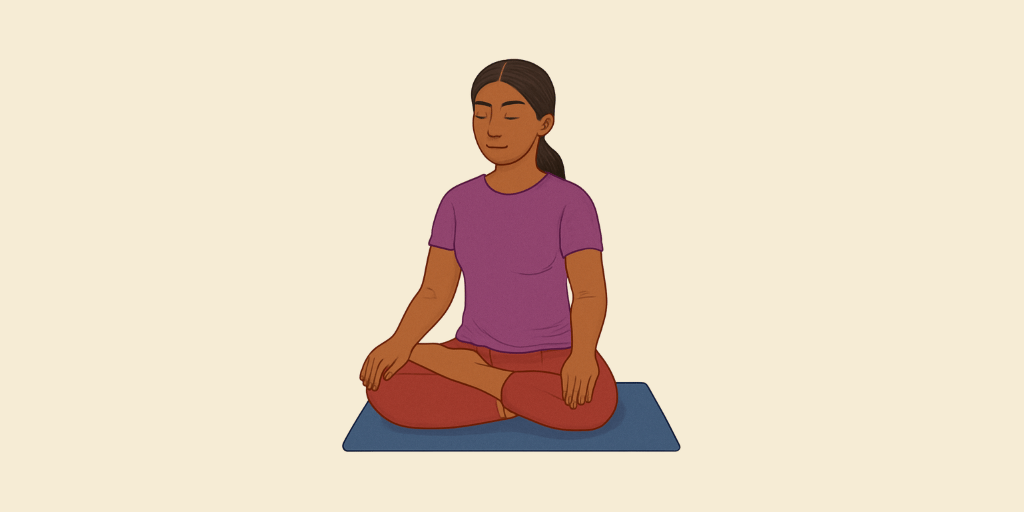Sanskrit Name: गोरक्षासन
English Name: Yogi Gorakhnath’s Pose
Description:
Gorakshasana is a seated yoga pose where one sits cross-legged (Padmasana or Sukhasana) and balances the body on the perineum, lifting the torso and legs. The term Gorakshasana is derived from two Sanskrit words: Goraksha (गोरक्ष), meaning “protector of cows” or “guardian of cattle,” which refers to Gorakhnath, a revered ancient yogi and significant figure in the Nath tradition, and Asana (आसन), meaning “pose” or “posture.” Hence, Gorakshasana translates to “Pose of Goraksha” or “The Protector of Cattle Pose,” honoring Gorakhnath, a foundational figure in the Nath Yogis and Hatha Yoga’s evolution. This posture is believed to have originated within the Natha Yogis’ tradition, which emphasized the balance of physical strength and spiritual awareness. The pose symbolizes the yogic strength and discipline of Gorakhnath, requiring intense concentration and physical control, especially in the pelvic area, spine, and legs. It is said to activate the root chakra (Muladhara) and enhance mental focus, physical stability, and strength.
Benefits:
Gorakshasana, also known as the “Cowherd Pose,” offers several therapeutic benefits:
- Improves Posture: Regular practice helps align the spine and improve overall body posture.
- Enhances Flexibility: Stretches the hips, thighs, and lower back, increasing flexibility in these areas.
- Strengthens Core Muscles: Engages the abdominal muscles, contributing to a stronger core.
- Promotes Relaxation: The pose encourages a meditative state, reducing stress and promoting mental calmness.
- Improves Circulation: Enhances blood flow to the lower body and helps invigorate the entire system.
- Relieves Sciatica: Can alleviate discomfort associated with sciatica by stretching and strengthening the lower back and legs.
- Balances Energy: Aids in balancing the body’s energy, promoting a sense of well-being.
Medical Conditions(Relief):
These benefits make Gorakshasana a valuable addition to one’s yoga practice for both physical and mental health. Gorakshasana, or the Cowherd Pose, is beneficial for various medical conditions. It aids in alleviating stress and anxiety, enhancing focus and concentration, and improving flexibility in the hips and lower back. Additionally, it can assist in managing respiratory issues by promoting better lung function and is known to support digestive health by stimulating abdominal organs. Regular practice may also help in reducing symptoms of insomnia and enhancing overall mental clarity.
Medical Conditions(Avoid):
Gorakshasana, or the “Yogic Sleep Pose,” should be avoided in the following medical conditions:
- Severe Back Problems: Individuals with serious spinal issues, such as herniated discs or severe sciatica, should avoid this asana to prevent exacerbating their condition.
- Pregnancy: Pregnant women should refrain from practicing Gorakshasana, as the pressure on the abdomen and changes in balance can pose risks.
- Knee Injuries: Those with knee injuries or chronic knee pain should avoid this pose, as it requires significant knee flexion and can lead to further injury.
- Hip Issues: Individuals with hip problems or conditions like bursitis should not practice this asana, as it can strain the hip joints.
- Cardiovascular Conditions: People with serious heart conditions should avoid this pose, as it may cause undue stress on the heart due to the body’s position.
- Recent Surgeries: After any surgery, especially abdominal or orthopedic, one should avoid Gorakshasana until fully healed and cleared by a healthcare professional.
- Severe Anxiety or Panic Disorders: Those with severe anxiety or panic disorders may find the pose uncomfortable and should avoid it to prevent triggering symptoms.
Always consult with a healthcare provider before attempting new yoga practices, especially if you have existing medical conditions.

